
The Caproni Ca.1 was an Italian heavy bomber of the World War I era.
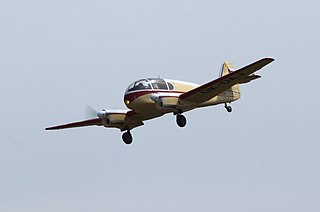
The Aero 45 was a twin piston-engined civil utility aircraft produced in Czechoslovakia after World War II. Aero Vodochody produced the aircraft in 1947–1951, after which the Let Kunovice rolled out these planes until 1961. In 1958 the Ae-45S became the first Czechoslovak plane to cross the Atlantic Ocean. It was the first product of the nation's postwar aviation industry and proved a great success, with many of the 590 produced being exported.

The Aero Letňany A.10 was a biplane airliner produced in Czechoslovakia shortly after World War I. It was the first commercial aircraft to be built in Czechoslovakia and was known as the Ae-10 Limousine. It was designed by Husnik and Vlasak and was intended to meet the growing need for aerial communication to and from the country. Behind the single nose-mounted engine was a cabin with seats for three and two tables, upholstered on the underside, and able to be inverted to provide another two seats if required. A double skinned firewall between the engine and cabin, together with double skinned surfaces to the walls, floor and roof and Triplex windows gave a (relatively) quiet ride. A rear window gave communication with the pilot, whose open cockpit was above and behind the cabin. The cockpit also accommodated the navigator who had a seat directly behind the pilot.
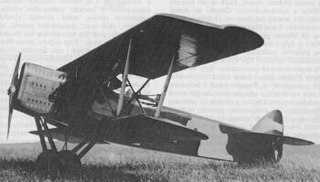
The Aero A.11 was a biplane light bomber and reconnaissance aircraft built in Czechoslovakia between the First and Second World Wars. It formed the basis for many other Czechoslovakian military aircraft of the inter-war period. Around 250 were built, with some remaining in service at the outbreak of World War II.

The Aero A.12 was a Czechoslovakian biplane light bomber and military reconnaissance aircraft manufactured in small numbers shortly after World War I. Although reminiscent of the Hansa-Brandenburg-designed aircraft that Aero was building during the war under licence as the Ae.10, the A.12 was the company's own design. It is perhaps most significant as the direct descendant of the highly successful A.11 and its various derivatives. An example of the type is preserved at the Letecké Muzeum in Kbely.
The Aero A.26 was a Czechoslovakian military reconnaissance biplane aircraft built by Aero Vodochody in the 1920s. It was Aero's last design to be based on the Hansa-Brandenburg B.I aircraft that the company had been building under licence during World War I as the Ae.10.

The Aero A.100 was a biplane light bomber and reconnaissance aircraft built in Czechoslovakia during the 1930s. It was the final step in a design lineage that extended back to the Aero A.11 a decade earlier. A.100s remained in service throughout World War II and for a few years postwar.
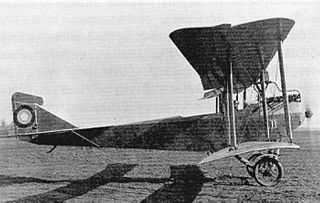
The Aero Ae 01 was a Czechoslovakian military trainer biplane built in 1919 and was Aero's first attempt to modify one of the aircraft designs they had been manufacturing under licence during World War I, the Hansa-Brandenburg B.I. It was designed by Antonín Vlasák under the direction of Jan Kouril. The project was originally designated as Ae 10, but later re-designated to Ae 01. The army operated the aircraft under designation A-1.

The Aero Ae 04 was a Czechoslovakian biplane fighter aircraft of 1921. A development of the Ae 02, it was no more successful than its predecessor in attracting purchase orders, and it flew only in prototype form. Undaunted by the lack of interest, development continued as the A.18.

The Albatros Dr.II was a German prototype single-seat fighter triplane, the sole example of which flew in the spring of 1918. It was similar in many respects to the D.X biplane, employing among other features the same 145 kW (195 hp) Benz Bz.IIIbo engine and twin 7.92 mm (.312 in) machine guns.
The Avro 536 and its follow-on design, the 546 were developments of the 504 military biplane, marketed for civil use in the years following World War I. Principally intended for joyriding, the aircraft had greater wing area and a more powerful engine to lift four passengers, seated in two rows of side-by-side seats behind the pilot.
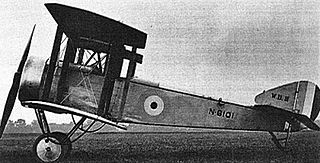
The Beardmore WB.III was a British carrier-based fighter biplane of World War I. It was a development of the Sopwith Pup that Beardmore was then building under licence, but was specially adapted for shipboard use.

The Hansa-Brandenburg CC was a single-seat German fighter flying boat of World War I. It was used by both the Kaiserliche Marine and the Austro-Hungarian Navy.

The Letov Š-4 was a Czechoslovak single-bay, unstaggered biplane fighter and trainer in the 1920s.

The Besson MB.35 Passe Partout was a French two-seat spotter and observation floatplane, designed by Besson. It was intended to serve on Surcouf a very large submarine, stowed in a sealed hangar. The first aircraft was destroyed during trials and the second was converted to the MB.41, prototype of the Besson MB.411, which did serve on Surcouf.
The Bristol Type 32 Bullet was a British biplane racing aircraft. It was designed in 1919 by Frank Barnwell as a high-speed testbed for the Jupiter engine being developed in Bristol by Roy Fedden for the Cosmos Engineering company, and also to publicise the company's name by participating in air races.

The Douglas DF was a commercial flying boat built by Douglas Aircraft Company, first flown on 24 September 1936.
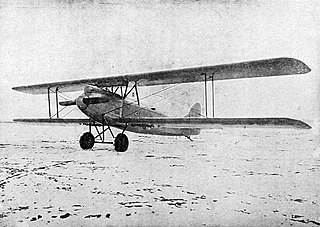
The Letov Š-6 was a bomber aircraft produced in Czechoslovakia during the 1920s. Derived from the Š-2, it was a biplane of conventional design. The wing cellule was an all-new design with a thicker profile, and while it had been intended to build them with a metal structure, wood was used instead due to shortages. Performance during testing was so promising that in 1924 an Š-6 was used to set a new altitude record with a 500 kg payload, and a national endurance record of 10 h 32 min.
The Sopwith Snapper was a prototype British fighter aircraft of the First World War. A single-engined biplane designed by the Sopwith Aviation Company to replace the Sopwith Snipe fighter, it first flew after the end of the war, but did not enter service owing to the failure of its engine, only three aircraft being built.

The LVG G.III was a large, twin engine triplane bomber built in Germany near the end of World War I. Only one was completed.

















